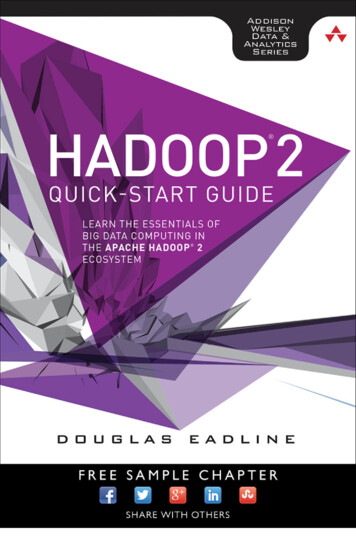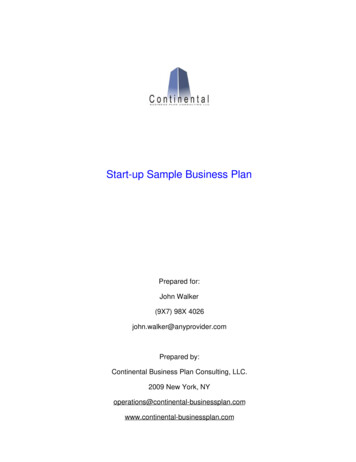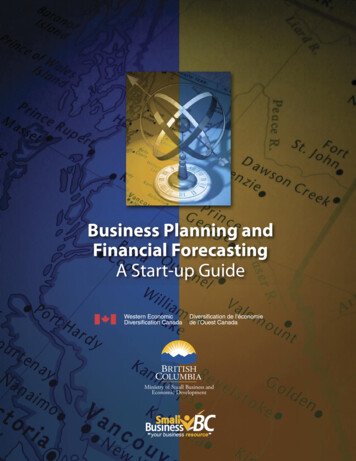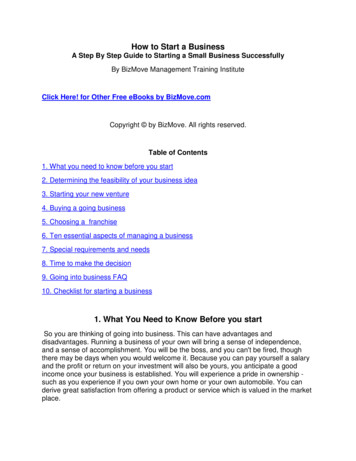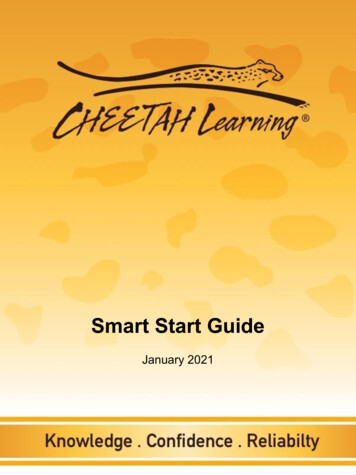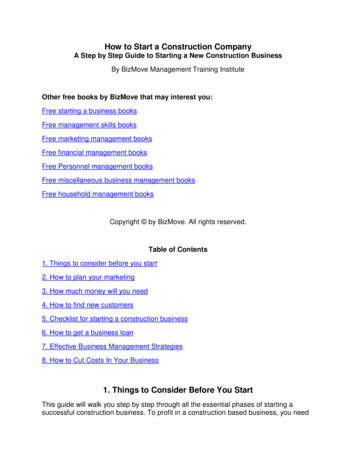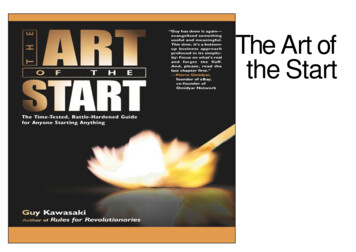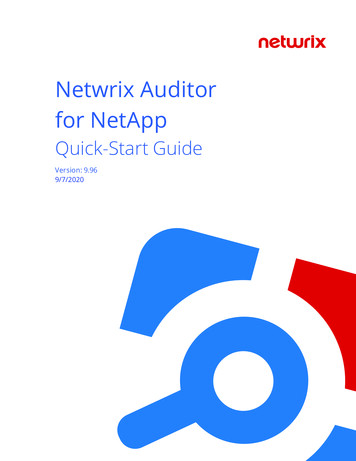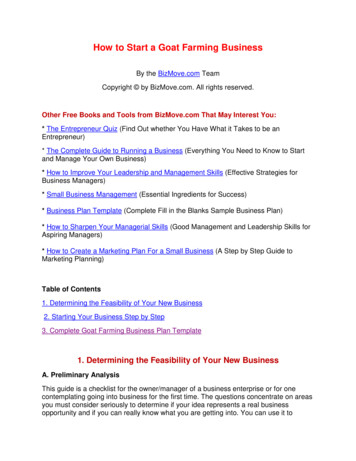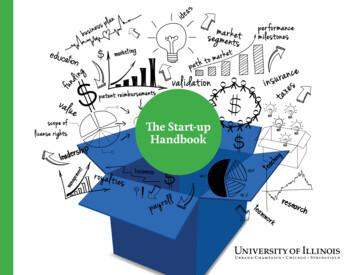
Transcription
The Start-upHandbook
The Start-up Handbook 2014 THE BOARD OF TRUSTEES OF THE UNIVERSITY OF ILLINOISALL RIGHTS RESERVED 1ST PRINTING, SPRING 2014
TABLE OFContentsINTRODUCT IO N . . . . . . . . . . . . . . . . . . . . . . . . . . . . . . . . . . . . . . . . . . 4Marketing . 14Marketing Analysis (The Five C’s) . 14FO RMI NG YO U R B U S IN ESS . . . . . . . . . . . . . . . . . . . . . . . . . 5Segmentation, the Target Market, and Positioning (STP) . 15Marketing Mix (The Four P’s) . 16Making the Decision to Form a Business . 5Feasibility considerations . 5Validating Your Idea . . 6U NIV E R SITY R ESO URCES FO R START-UPS . . 18Intellectual Property and Your Business . 7University Resources for Start-ups . . 18Inventions and Patents . . 7Proof of Concept funding . 18Copyright . . 7The Offices of Technology Management . . 19Licensing Intellectual Property from the University . 8University of Illinois Research Park . 19The University’s System for Technology Transfer . . 8EnterpriseWorks . . 19Licensing . . 9EnterpriseWorks programs . 19License Negotiations . 9EnterpriseWorks Chicago . . 21Developing a Business Plan . 10IllinoisVENTURES . . 22Points to Remember when Preparing the Business Plan . . 11Resources for Student Entrepreneurs . . 23Entities and Legal Formation of a Business . 12Business Entities at a Glance . . 13
F UNDI NG YO U R B U S IN ESS . . . . . . . . . . . . . . . . . . . . . . . 25HUM A N R E SOURCES . 31Types of Funding . 25Standard Labor and Employment Laws . . 31Funding Sources . 25Fair Labor Standards Act (FLSA) . 31Self-Financing . . 25Workers’ Compensation . 31Bootstrapping . 25Unemployment Insurance . 31Federal Grants . 25Equal Employment Opportunity . 31Loans . 26Tax Withholding . 31Business Plan Competitions . 26Employment Eligibility and New Hire Requirements . 32Joint Ventures . 27Non-Disclosure and Non-Compete Agreements,Conflict Acknowledgements . . 32Angels . 28Venture Capital . 28Securing Funds . 28The Business Plan . . 29ONLINE R E SOU RCES . . 33The Business Team . 29The Investor . 30CONTACTS . . . . . . 34
IntroductionInnovations generated by University of Illinois research havea profound impact on human issues and the creation ofbusinesses, jobs, and economic well-being. There are manyways to translate University technology and innovation intosocietal benefit; starting a company is one of them. TheUniversity has put in place a unique and comprehensive systemsupporting entrepreneurship and economic development.For a new entrepreneur, the question is where to start. TheOffice of Technology Management is proud to presentthis handbook as an introduction to both the University’sresources and to basic business concepts and considerations.We hope you find it useful.4 THE START-UP HANDBOOK
FormingYour BusinessMaking the Decisionto Form a BusinessStarting a company is one way to further developand commercialize technologies created at theUniversity of Illinois. Several factors shouldbe weighed when deciding whether to forma business. These considerations comprise afeasibility checklist and can be divided betweenexternal and internal factors.FEASIBILITY CONSIDERATIONSExternal considerations concern the marketplacefor the start-up’s product as well as the potentialperformance of the product in that market.Factors include: What product or service the start-up will offer Whether the product or service satisfies a needthat people value The price a customer would pay for the productor service The market’s size and effect on start-upprofitability The regulatory landscapeIdentifying the market need can be a challenge ifyour expertise is in technological development andinnovation rather than marketing and technologycommercialization. You should note that, nomatter how innovative a technology is, if it doesnot address an actual need at a price whichcustomers are willing to pay, the technology hasno market. If your start-up’s technology does notsolve an actual problem at a competitive price,then the start-up is more likely to fail.It is important to understand the market in whichyour technologies will compete. Knowledge ofa market can be acquired through professionalmarket research, government data, tradepublications, and networking with prospectivecustomers. The decision to form a start-upshould be made only after acquiring a strongunderstanding of the market and how your productor service would fit into that market.Internal considerations concern yourcommitment and willingness to start a business.Factors include: Available time Personal resources Risk tolerance Resilient and flexible attitude Managerial supportStarting a business requires a large timecommitment, and it is not uncommon for newentrepreneurs to underestimate the time needed.Additionally, you should consider your personalresources and whether you are comfortablecommitting those resources to the endeavor,although it is not always necessary to do so.Furthermore, while starting a business can leadto tremendous wealth, it comes at significant risk.The reality is that many start-ups fail. You shouldbe willing to accept this risk. Finally, unforeseenchallenges will always arise when starting a business.Consequently, it helps if you can adapt quickly tochanging conditions and remain committed to theendeavor, or recognize when to stop.Forming a Business 5
Validating Your IdeaWhen you are contemplating starting a company, one of your first stepsshould be to assure that you are creating a product or service that customerswill buy. The Customer Development Model, created by Steve Blank*, canhelp you do this.The model consists of four steps — customer discovery, customer validation,customer creation, and company building. Because each step is recursive,you may remain in each for any duration of time, refining and repeating theprocesses involved.1. Customer DiscoveryTarget potential customers and determine if the problem your product solvesis important to potential buyers.2. Customer ValidationDevelop a sales process that successfully sells your product.Starting a Company While Remaining at the UniversityWhen a start-up includes one or more University faculty members or other University employees,conflict of interest should be addressed. Depending on the circumstances, a conflict of interestmanagement plan may be needed.This plan outlines the relationship between your activities with the company and your researchand teaching responsibilities (see box on page 7). The plan identifies and mitigates possibleareas of conflict, such as those related to conflict of commitment and/or conflict of interest,as well as prepares for disclosure and management of these conflicts. To initiate a conflict ofinterest management plan, contact the Office of the Vice Chancellor for Research (OVCR) onyour campus.6 THE START-UP HANDBOOK3. Customer CreationBuild on the sales accrued during customervalidation and begin to put money into marketingyour product.4. Company BuildingTransition the company from an informaldevelopment team into a formal entity.On the Urbana campus, companies can pursuethis validation process through the NSF I-Corpsprogram which is designed to help Universityentrepreneurs recognize product opportunitiesarising from academic research. See page 20 formore information.
*For additional information on the CustomerDevelopment Model, consider reading The LeanStartup by Eric Ries and The Four Steps to theEpiphany by Steve Blank.invention so that others can reproduce and learnfrom it. In that way, the patent monopoly providesthe incentive to share advances with the public andthereby contribute to growth in the field.Intellectual Propertyand Your BusinessInventorshipInventorship is defined by U.S. patent law.Broadly, an inventor is one who alone, or togetherwith others, conceived of the ultimate workinginvention. A patent application must be filed in thenames of the true inventors. The legal criterion forinventorship is not the same as that for academicauthorship. Inventorship is not a reward forhard work to someone who only worked underdirection. Inventorship is tied to the claims ina patent application and is determined at the timethe patent application is filed. As the claims ina patent application change, so may inventorship.For many faculty start-ups, intellectual propertyis the business’ key asset and gives the start-up acompetitive advantage. The following subsectionsbriefly discuss intellectual property in the form ofinventions and patents, as well as copyright. For amore in-depth review, please refer to the Handbookfor Inventor’s and Innovators or talk to your Office ofTechnology Management (OTM).INVENTIONS AND PATENTSAn invention can be anything man-made thatis new, useful, and non-obvious. Inventionsmay include, but are not limited to, processes,methods, machines, articles of manufacture,devices, chemicals, and compositions of matter.Inventions can be protected by patents.U.S. law recognizes the value of innovation to theeconomy and provides the owner of a patent witha time-limited monopoly (20 years) to preventothers from exploiting the invention withoutpermission. In exchange for this exclusive right, thepublished patent document must fully describe theOwnershipInventorship does not equal ownership.Organizations usually own the inventionsdeveloped by their employees. The Boardof Trustees of the University of Illinois ownsUniversity of Illinois patents, as established byArticle III of the University’s General Rules.Conflict of InterestResponsibilities Obtain prior written approval toengage in non-University incomegenerating activities. Disclose such activities annually,whenever a substantial change occurs,or when required by granting agencies. Refrain from spending so much time onexternal activities that they interfere withyour University responsibilities. Refrain from advancing your own interestor the interest of family members to thedetriment of the University’s interest. Disclose involvement of Universitystudents or employees in yourexternal activities. Work with the department head toidentify and evaluate potential conflicts,and manage or eliminate them.COPYRIGHTCopyright is the form of intellectual property thatprotects the expression of a creative idea that isfixed in a tangible form. It is an acknowledgementof who created the work.Forming a Business 7
For example, in The Wizard of Oz, copyrightprotects the order of the words in the story, aswell as the layout of the pictures, color, and wordson the page. The ideas, plot, and characters arenot protected. Each adaptation of this classictale (book, screenplay, movie, music) generatesindependently copyrighted works.the work without permission. Works owned bythe University should bear the following copyrightnotice: 20XX The Board of Trustees of theUniversity of Illinois. All rights reserved.For scientific writing, copyright does not protect theprocedures, systems, processes, concepts, formulas,discoveries, or devices described in the work.Similarly, for software, copyright does not protectthe underlying concepts, processes, systems,alogrithms, program logic, or layouts.Author owned copyrights last for the life of theauthor(s) plus 70 years after the last survivingauthor’s death. Employer owned copyrights lastfor 120 years from the work’s creation or 95 yearsfrom the first publication of the work, whicheveris shorter.Copyright constitutes a bundle of legal rights,which include the right to copy, display, perform,distribute, and make changes to the originalcopyrighted work. These altered versions oforiginal works are known as derivative works.Copyright provides the owner with the right todetermine how the work is copied and distributedto others, such as through traditional or onlinepublication, open access, sale, lease, or lending. Italso gives the copyright holder the right to chargeroyalties for a work’s use.Licensing IntellectualProperty from theUniversityAutomatic Application of CopyrightUnlike patentable inventions, copyrightedworks are automatically protected under U.S.copyright laws without having to undergo aformal registration process. However, it is stillimportant to affix an appropriate copyright noticeto notify others that they are not free to utilize8 THE START-UP HANDBOOKThere is also a formal registration process todocument copyright in the Library of Congress.Usually, the cornerstone asset of a facultystart-up is the intellectual property ownedby the University. The following sectionsbriefly discuss the University’s system fortransferring intellectual property into a startup via a license. For more detailed informationconcerning intellectual property and theUniversity’s process to evaluate and protectintellectual property, see A Handbook forInventors & Innovators.THE UNIVERSITY’S SYSTEM FORTECHNOLOGY TRANSFERThe University has resources designed tofacilitate all stages of the technology transferprocess. Overseen by the Office of theVice President for Research (OVPR), theUniversity’s technology commercializationinfrastructure is comprised of several entitiesand many programs.Entities The Offices of Technology Managementon the Urbana and Chicago campuses evaluate,patent, and license the University’s intellectualproperty. IllinoisVENTURES LLC provides consultativeservices, funding, and business developmentsupport for early stage, research-drivencompanies, particularly those deriving fromthe University of Illinois, other Midwesternuniversities, and Federal laboratories. The University’s Research Parksand incubators in Urbana and Chicagofacilitate the growth of early stage companies,encourage R&D collaboration between theUniversity and private industry and publicagencies, and attract established companiesthat benefit from close working relationshipswith University faculty and students.Each of these entities, along with many other units,offers many supporting programs for entrepreneurs.
For more information, see the University Resourcesfor Start-ups section on page 18.LICENSINGA license is a written agreement granting someor all of the University’s rights as owner of anintellectual property (licensor) to a company(licensee). The licensee undertakes certainobligations and responsibilities to commercializethe intellectual property.The University licenses its varied technologies(patents, software, databases, creative works) tocompanies or individuals that demonstrate thecapability and commitment to develop early stageinnovations into commercial products or services.If you would like to license University technologiesfor use in your start-up, you will be asked todemonstrate such commitment by providing awritten technology and business developmentplan. This plan should include but is not limited toa description of the technologies to be licensed,the resulting product, market analysis, a productdevelopment timeline, and the company resourcescommitted to development.The terms of the license are negotiated basedon factors such as the type of technology, theindustry area, the level of development, the timeto market, and the licensee’s commercializationplan. The terms should anticipate potential pivotsin the company’s strategy to accommodate themarket or the product.LICENSE NEGOTIATIONSThe licensing process begins by discussing a termsheet summarizing the essential business termsof the agreement. Below are the types of businessterms generally addressed.Scope of License RightsLicense rights — such as exclusive, nonexclusive,field-of-use limitations, and territory limitations— are established to be commensurate withthe licensee’s product development plansand the market. The University’s licensingobjective is to obtain widespread use of itstechnologies through a well thought outcommercialization plan.the significance of the invention to the productor service, and the base upon which the royaltyis applied (e.g., unit, component, subsystem).Royalty payments may be structured in differentways, such as one-time or recurring fees.Sublicense SharingExclusive licenses usually allow the right tosublicense, or authorize others to make, use, and/or sell the University’s technology to facilitatewidespread use. Revenues you receive fromsublicenses are also shared with the University.License FeeAn initial fee based on thescope of license rights andthe University’s investmentin the intellectual property.RoyaltiesYour company will beexpected to pay royaltieswhen products or servicesthat require the use ofthe technology are soldor transferred. Royaltiescan be expressed as apercentage of sale ora fee per selling unit.Royalty rates varyaccording to the industry,Forming a Business 9
Minimum RoyaltiesMinimum royalty payments are established toencourage diligence in developing and sellingproducts or services based on the technology.Patent ReimbursementRecovery of the costs incurred by the Universityfor protecting the technology in the U.S. and othercountries is part of the license. Typically, patentcosts that accrue prior to licensing are repaid via apayment plan, while patent costs during the termof the license are paid as they are incurred.Performance (Diligence) MilestonesUniversity technologies often require significantadditional development before they are ready forthe market. You will be asked to provide periodicreports and meet specific milestones in order toretain the license, especially an exclusive license.Milestones are usually industry specific.License ComplianceAfter you license University technology, yourOffice of Technology Management will managethe license to ensure all terms and conditions areadhered to and the technology reaches its fullestpotential.If the terms and conditions are not met, thelicense may be terminated or revised, in whichcase the invention may become available forlicensing to another company.10 THE START-UP HANDBOOKDeveloping aBusiness PlanA business plan is a strategic description of howyour start-up will advance its technology andachieve profitability and success. It is a livingdocument and will need to be revised to reflectthe changing conditions of the business and themarket in which it operates.The true value of developing an initial businessplan is not the finished product itself, but theresearch and thought behind the plan. Creating abusiness plan helps you systematically consider allaspects of the business. Additionally, a businessplan is critical for a start-up that is trying tosecure external funding. The business plandemonstrates to outside investors that you havethoroughly explored both the market and how yourproduct or service fits in that market. The levelof detail in the plan will depend on the types ofinvestors or funding you are seeking.The remainder of this section will look at some of themost important parts of a business plan. However, itis not a comprehensive guide, but an introduction tothe various elements you should consider.Executive SummaryThe executive summary is a snapshot of thebusiness. It acts as an elevator pitch and is usuallythe first opportunity to catch the interest of aninvestor. Consequently, it is the most importantpart of the plan. It should answer these questions: What is the company’s mission? Why is it important? How will the company make money pursuingits mission? How will the company develop its technologyinto products? What experience do the founder andmanagement team have? How much money is necessary? What level of return can an investor expect? Why that level of return?Business DescriptionThe business description provides more extensiveinformation concerning your company’s missionthan was provided in the executive summary. If theexecutive summary is an elevator pitch, then thebusiness description is similar to an extended, moredescriptive elevator pitch, helping investors quicklyunderstand the business’ goals and its uniqueposition. The business description should include: The nature of the business and the marketplaceneeds the business will satisfy An explanation of how the start-up’s products,technologies, or services address those needs The specific companies or customers the startup will serve The competitive advantages the start-up has,such as personnel, technology, or value creation
Market AnalysisThe market analysis presents market researchshowing the current state of your start-up’sindustry segment, as well as the target marketfor your product or service. At a minimum, themarket analysis should contain: A specific description of the target market The revenues and growth rates of the market,including a five-year projection A demonstration of a strong market need foryour product or service A competitive analysis The results of marketplace interviews or otherprimary market researchInvestors want to know that you have carefullyconsidered and fully understand the marketyour start-up will target. Further, the marketanalysis must honestly address the competitiveenvironment. Unfortunately, there is no marketthat is void of competition, and investors arekeenly aware of this. Even new products inso-called “uncontested markets” face indirectcompetition from substitute offerings. Theanalysis should acknowledge this reality.Additionally, most investors want to seeindependent evidence of market validation.Examples of this include the results of your marketresearch, customer surveys, and interviews.Marketing PlanThere are many factors that go into the marketingprocess, which will be highlighted in greater detailin the Marketing section of this handbook (page14). For the business plan, it is important to showhow your product or service will be positioned inthe minds of customers versus the competition.Elements deserving consideration are: Key factors in the customer selection process Customer perception of competitorperformance in the key factors How your start-up’s offering will perform in thekey factors Market share goals and how they will be achievedManagement TeamThe management team section defines the rolesof the management team and presents theirbiographies. Investors prefer to see that the teamhas relevant business and technical experience.FinancialsThe financials should provide the current statusof the business and a realistic expectation of itsposition after five years. The goal is to determinethe cash needed for the start-up to succeed, aswell as the reasonable revenues and profits thatcan be expected from the investment. A fiveyear projection will necessitate making someassumptions. These assumptions should be noted.You should also be prepared to justify on whatbasis the assumptions were made. Additionally,this section should detail how any cash invested inthe business will be used.POINTS TO REMEMBER WHENPREPARING THE BUSINESS PLANTo reiterate some of the most important conceptsyou should be mindful of when preparing thebusiness plan: Focus on the customer and the market need,NOT on the technology Acknowledge your competition honestly Include elements of the strategic plan Ask for ongoing feedback from an experiencedentrepreneur Discuss current capital structure Make sure the plan flows narratively fromsection to section Keep the business plan as succinct as possibleForming a Business 11
Entities and LegalFormation of a BusinessBusiness entities are ways to classify theorganization of your business as recognizedby law. While you have many entity optionsavailable to legally form the business, there arethree that merit particular attention becausethey are common entities for technology-drivenstart-ups: C corporations, Limited LiabilityCorporations (LLCs), and S corporations. Theseentities differ significantly regarding taxation,ownership, fundraising, governance, andemployee compensation.Selection of the business entity that best suitsa particular start-up should be done with theconsultation of an attorney and/or accountantwho has experience advising start-up companies.Consequently, the following sections are meant asan introduction to common business entities andshould not be construed as professional advice.C CorporationsC corporations are separate taxable entities fromtheir shareholders. Consequently, the earningsof a C corp are generally taxed twice: first at thecorporate level based on the taxable earnings ofthe corporation, and then at the shareholder levelbased on distributed dividends. C corporationsmay have an unlimited number of shareholderswho are not required to manage the corporation’sday-to-day operations.12 THE START-UP HANDBOOKGenerally, venture capital investors prefer toinvest in C corporations because of a C corp’sability to issue preferred stock to investors. Thestructural accountability of a C corp is welldefined, with management reporting to the boardof directors. C corporations can issue incentivestock options to employees, giving employees anequity stake in the success of the corporation.LLCsFor tax purposes, LLCs are flow-through entities.Corporate revenue is not taxed at the corporatelevel but passes through to the LLC’s owners,where it is taxed at the individual level. Like Ccorporations, LLCs may have an unlimited numberof owners. However, transference of ownershipis more difficult, usually requiring the approval ofthe other owners. For this reason (among othersnot touched on here), venture capital investorsgenerally do not favor investing in LLCs.Additionally, the pass-through tax treatment ofLLCs can cause undesirable taxable income toinvestors. LLCs generally operate without theformalities of a C corp, with the owners managingthe day-to-day operations. An LLC may offermembership interests to employees, but cannotoffer incentive stock options.S CorporationsS corporations, similar to LLCs, are generallyflow-through entities for tax purposes, withthe S corp’s taxable income distributed toits shareholders in equal proportion to theirownership share. S corporations may have nomore than 100 shareholders. Additionally, theshareholders must be individuals, with somelimited exceptions.Like C corporations, S corporation ownershiptransference is flexible. However, S corporationsdo not have the ability to issue multiple classesof stock. Most venture capital investors wantpreferred (rather than common) stock as acondition of the investment. Consequently,S
Development Model, consider reading The Lean Startup by Eric Ries andThe Four Steps to the Epiphany by Steve Blank. Intellectual Property and Your Business For many faculty start-ups, intellectual property is the business’ key asset and giv


